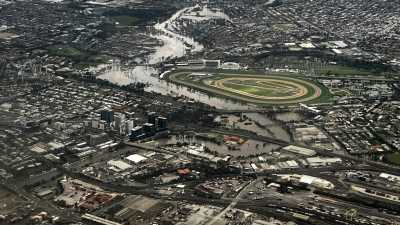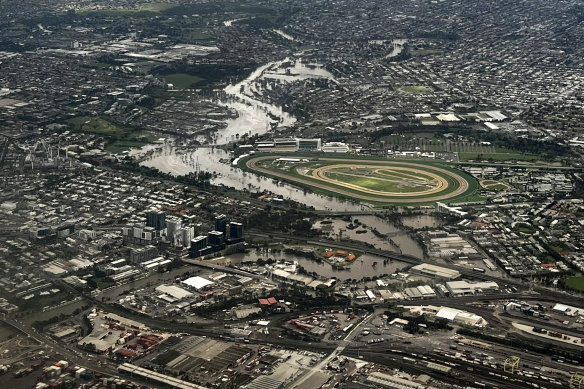
Melbourne Water points finger of blame at weather bureau over Maribyrnong flood disaster
April 15, 2023Save articles for later
Add articles to your saved list and come back to them any time.
Our live coverage of the extreme weather is free for all readers. Please consider supporting our journalism with a subscription.
Melbourne Water will upgrade its decades-old Maribyrnong River flood modelling after it failed to predict that a major deluge would hit hundreds of homes until six hours before disaster struck in October last year.
The government-owned water authority does not admit to mistakes but places some blame for its failure to adequately warn residents in the city’s inner north-west on the Bureau of Meteorology’s rainfall forecasts.
The Flemington racecourse floodwall kept the track in perfect condition on October 14. In the background is the flooded suburb of Maribyrnong.Credit: Emma Johnston
Melbourne Water has released a 36-page submission prepared for its own trouble-plagued inquiry into the Maribyrnong River flood – one of 62 submissions it received before the March 17 cutoff and published on Friday on the flood’s six-month anniversary.
Melbourne Water’s submission sheds no light on whether the controversial Flemington Racecourse flood wall had an impact on the October 14 disaster, despite its construction having been named as a key focus of its inquiry following widespread community anger.
“A complex hydraulic and hydrologic model would need to be completed,” it reads. “It is usual for modelling of this kind to take at least 12 months.”
The flood wall was built in 2007 with a permit granted by then Labor planning minister Mary Delahunty and green-lit by Melbourne Water with mitigation works, despite being opposed by three councils and local residents.
Melbourne Water has also failed to finish an investigation into the development of the Rivervue retirement village in Avondale Heights, where 47 top-end homes flooded in October. In 2015, Melbourne Water initiated a change to planning rules that removed designated flood-prone land over much of the property and led to the developer building homes that became unexpectedly swamped.
“We will provide updated information to the Independent Review Panel as it becomes available.”
Former Federal and Victorian Supreme Court judge Tony Pagone, who chaired the royal commission into aged care in 2019, has also been announced as the inquiry’s new lead after the review’s first appointed chair, Nick Wimbush, resigned over a perceived conflict of interest in February.
More than 600 properties in Melbourne’s north-west were hit in the October 14 flood, which was the worst in 48 years and the third-largest since records began in the late 1800s.
Melbourne Water’s submission states that the most recent flood modelling for the lower Maribyrnong River was commissioned in 2003, using hydrological work completed in 1986 as its starting point.
“It is common practice for updated flood models to build from data sets used in previous models,” it said.
The water authority says that “valuable information” from the October flood will be used to improve its modelling, but adds there is no regulated standard for the frequency of updating flood models.
Melbourne Water is examining how it can better resource its flood-modelling work.
“The process of creating a model is long and resource intensive. Melbourne Water has finite resources for updating flood modelling across the whole Melbourne region. Our flood-modelling program is prioritised on the need for completing areas not currently modelled and mapped.”
Engineering firm Jacobs was hired to analyse actual data against modelled data, however the results have not been published. “Melbourne Water is undertaking further analysis to understand any discrepancies.”
Climate change is named as a complicating factor that will be embedded into new modelling.
“Extreme rainfall events in greater Melbourne will become more intense through the next century,” the submission states. “This is making it harder to rely on historic data to predict future floods. Given this known future impact, it is no longer adequate to use past rainfall events as an indicator of the potential future events.”
Detailing the events leading up to the morning of October 14, the submission places some blame on the Bureau of Meteorology’s rainfall forecast, explaining it was revised down on the afternoon before the flood and led to Melbourne Water downgrading its flood prediction to “moderate” at 2.24pm.
Twelve hours later, the flood warning was again upgraded to “major”, but most residents had already gone to sleep not anticipating any danger.
“Around 12.30am on October 14, Melbourne Water identified that the real-time data showed the river was rising faster than the model had predicted. Melbourne Water updated its predictions.”
The submission states that the rain forecast changed several times, while conceding “this is not unusual” because predictions become more accurate closer to the time of the rainfall.
“The Maribyrnong catchment had already received large volumes of rainfall in the preceding weeks by the time of the storm event … This means that the above-average rainfall on an already wet catchment created larger than normal volumes of runoff.”
Melbourne Water argues in its submission that more needs to be done to help the community understand flood risk, similar to how Victoria improved bushfire preparedness.
It cites a 2018 survey that found only 44 per cent of households in flood-prone areas were aware of their flood risk.
“The flood risk profile of a city is less quantifiable under conditions of changing rainfall patterns due to climate change. This can have unintended consequences such as creating a sense of complacency that can cause communities to be less prepared.”
Melbourne Water’s inquiry panel will now review all submissions before compiling its findings in a report to be published later this year.
The inquiry has been mired in controversy since it was revealed it would not examine several matters, including early warning systems and urban planning.
A parliamentary inquiry was later established after the Coalition, Greens and crossbenchers teamed up to launch a wider-ranging flood review. Submissions for that review are open until May 8.
The Morning Edition newsletter is our guide to the day’s most important and interesting stories, analysis and insights. Sign up here.
Most Viewed in National
From our partners
Source: Read Full Article



